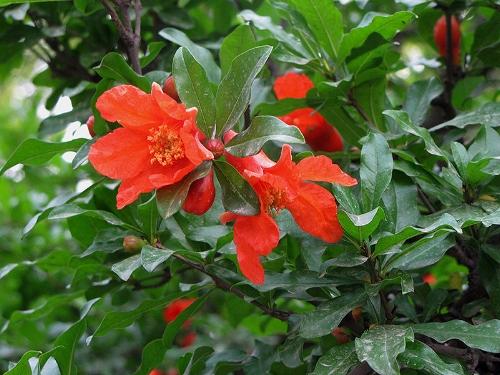Pomegranate (Punica granatum)
Arabic name: رمان
The Pomegranate (Punica granatum) is one of the longest cultivated fruit trees. It is native in areas from southeast Europe through western Asia to the west Himalayas. The Pomegranate’s large red flowers, red-gold fruit, and glossy green leaves have inspired countless allusions in literature and art, and the Pomegranate’s fruit has long been considered a symbol of beauty and fertility.
It is extensively planted throughout the Mediterranean region, and is familiar as both a tree, and a large shrub. This summer-flowering tree is grown for its bright red flowers, and also for its reddish edible fruit. In addition, the red-bronze color of the Pomegranate’s new spring foliage, and the yellows of its dying leaves in the fall are both striking.
This beautiful deciduous tree can grow to a height of 5m, with a spread of 5m, and has a moderate growth rate of about 25cm per year. Its red flowers appear from May to July.
Requirements:
Pomegranates grow in full sun, and are drought-tolerant. They grow best in fertile, well-drained soil.
Water usage:
Pomegranates require some irrigation once established. Generally, trees need supplemental irrigation to get established, especially if planted after the rainy season. During the first year, irrigate in the amount of 20 – 25 liters of water twice a week. During its second year, a tree needs to be irrigated in the amount of 40 liters once a week. Beginning with the third year, trees usually get established, and some, like the Pomegranate, require some supplemental irrigation in the amount of 50 – 60 liters once a month.
Appearance:
The Pomegranate is a deciduous, rounded tree, or large shrub that is sometimes single-trunked, but often is seen with many low-branching trunks. Old specimens often assume a picturesque gnarled appearance.
The leaves are shiny green, narrowly oblong with wavy margins, and are 5 – 7.5cm long, and 2.5cm wide. The Pomegranate has copper-colored young growth in the spring, and yellow tints in the fall. The twiggy branches are spiny. The bright red early summer flowers appear in clusters of 1 to 5. They are tubular and have a carnation-like appearance, with crumpled petals. The flowers become deep red fruits that ripen in the fall and early winter. The spherical fruit is about the size of an orange. The outer covering is hard and leathery, often splitting to expose the pulp-covered crimson seed held within.
Notes on use:
A fruit-bearing specimen tree; characterized by its attractive flowers. Suitable as a solitary tree.
Propagation:
Propagate by seed in the spring, or by semi-ripe cuttings in the summer.
Maintenance:
The Pomegranate is a relatively low maintenance plant, but due to its shrub-like form, it might need pruning to develop a standard tree. Trees grown for fruit production should be pruned to eliminate the numerous basal shoots. Thinning during the winter months will help shape the structure of the tree. Avoid shaping it too high for the fruits to be picked by hand. Do not prune prior to the spring flowering period in order to enjoy the flowering display.
Fertilize sparingly in early spring.
Comments:
In addition to eating the fruit fresh, the fruit can be used in the preparation of syrups (especially grenadine) and jams. Pomegranate fruits are also attractive to birds. Exposure to heavy watering during fruiting may cause the fruit to split prematurely.
Pomegranates tolerate high heat. They also tolerate and grow well in alkaline soils that would kill most plants.
Image source: https://www.gardensonline.com.au/GardenShed/PlantFinder/Show_1586.aspx
Image source: https://medium.com/@mdashikurr2/sugar-and-anthocyanin-characterization-of-four-iranian-pomegranate-punica-granatum-l-98665a42f32f
Image source: http://plants.squakmtnursery.com/12230001/Plant/14219/Pomegranate/
This article is part of a series of articles prepared by the Center for the Study of the Built Environment (CSBE) on water conserving landscapes.
For additional information on water conserving gardens, visit the CSBE web site at www.csbe.org
Support for the CSBE project on water conserving landscapes is provided by WEPIA (Water Efficiency and Public Information for Action), a program being implemented in collaboration with the Ministry of Water and Irrigation and funded by the United States Agency for International Development (USAID).



